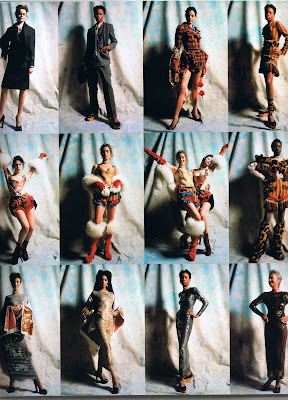

Color Scheme :
- Analogous Color Scheme
- Compementary Color Scheme
- Analogous Color Scheme
- Compementary Color Scheme
- Achromatic Color Scheme
The below outfits are using Achromatic Color Scheme , which is blacks and add the gold color as the partten . I think no matter the outfits design and the color are match with the collection's theme : historicism. It create the a feeling of classic.
The below outfits are using one colour, which is red-orange , blue and orange respectively.
It is interesting is that I find when these color are combined that can create the complementary color effect.
It is interesting is that I find when these color are combined that can create the complementary color effect.
The below outfits are using Analogous Color Scheme. The left one is using blue and green color ; the middle is using dark green and light yellow ; the right one is using light brown which matched with a light yellow glove to create the Analogous Color effect. I found that alought Westwood used different value of different color , when the color she used are lying adjecent to each other on the color wheel , it can create the feeling of harmaony, just like the below outfits.
The below outfit is using Compementary Color Scheme, which is using Red-orange and blue. Alought just little blue is added in this outfit, it create a contrast effect and make the outfit became more shape and attractive.
______________________________________________________



This dress was inspried by The Mirror with marquetry by Andre-Charles Boulle. French, 1713 Wallace Collection.
______________________________________________________
About the collection
The dominant theme of the 1990s was historicism.
The dominant theme of the 1990s was historicism.
Vivienne Westwood said : "Fashion as we know it is the result of the exchange of ideas between France and England,"
The most characteristic aspect of Westwood's work in the 1990s is its historicism. Her revelation is that fashion is profoundly enriched by renewal and reinvention, and she believes this to be a radical departure. She once said: 'I am a great believer in copying; there has never been an age in which people have so little respect for the past'.
In Portrait (Autumn/Winter 1990–91) Westwood created one of her richest and most elaborate collections at a time when minimalism was becoming prevalent. Her intention was to suggest that her models had just stepped out of a painting. She used rococo designs derived from 18th-century furniture printed in gold ink on to stretch black velvet and photographic prints of Boucher's paintings on shawls and corsets.

Boucher's paintings on shawls and corsets.
Later, her love of painting was expressed in creations that emulated the very quality of the artist's technique, for example in her Gainsborough blouse, its edges gently frayed to suggest fine brushwork, and in sumptuous ball gowns styled in the spirit of Winterhalter.

She has found inspiration in the furniture of Andre Charles Boulle in her Portrait collection A/W 1990, creating elegant dresses in black velvet over-printed in gold. Westwood created a silk evening dress based on the eighteenth century artist François Boucher's portraits of Louis XV's mistress, Madame de Pompadour, for her Anglophilia collection, recreating the crumpled silk taffeta. Despite her exactitude, Westwood's creations are never historical facsimiles; 'I take something from the past that has a sort of vitality that has never been exploited - like the crinoline - and get very intense. In the end you do something original because you overlay your own ideas.'
The most characteristic aspect of Westwood's work in the 1990s is its historicism. Her revelation is that fashion is profoundly enriched by renewal and reinvention, and she believes this to be a radical departure. She once said: 'I am a great believer in copying; there has never been an age in which people have so little respect for the past'.
In Portrait (Autumn/Winter 1990–91) Westwood created one of her richest and most elaborate collections at a time when minimalism was becoming prevalent. Her intention was to suggest that her models had just stepped out of a painting. She used rococo designs derived from 18th-century furniture printed in gold ink on to stretch black velvet and photographic prints of Boucher's paintings on shawls and corsets.

Boucher's paintings on shawls and corsets.
Later, her love of painting was expressed in creations that emulated the very quality of the artist's technique, for example in her Gainsborough blouse, its edges gently frayed to suggest fine brushwork, and in sumptuous ball gowns styled in the spirit of Winterhalter.

She has found inspiration in the furniture of Andre Charles Boulle in her Portrait collection A/W 1990, creating elegant dresses in black velvet over-printed in gold. Westwood created a silk evening dress based on the eighteenth century artist François Boucher's portraits of Louis XV's mistress, Madame de Pompadour, for her Anglophilia collection, recreating the crumpled silk taffeta. Despite her exactitude, Westwood's creations are never historical facsimiles; 'I take something from the past that has a sort of vitality that has never been exploited - like the crinoline - and get very intense. In the end you do something original because you overlay your own ideas.'



This dress was inspried by The Mirror with marquetry by Andre-Charles Boulle. French, 1713 Wallace Collection.
This long , red barathea open jacket with black velvet collar and pockets was copied from the 18th century portrait, The boy with a bat. This jacket is teamed with a high - waisted pencil skirt and a silk ' Boucher' scarf.












No comments:
Post a Comment